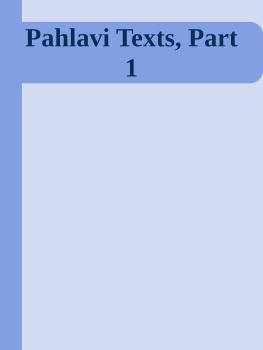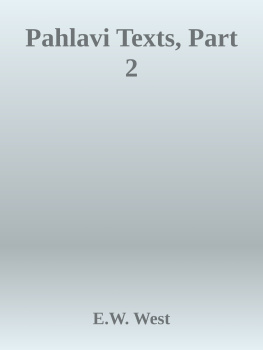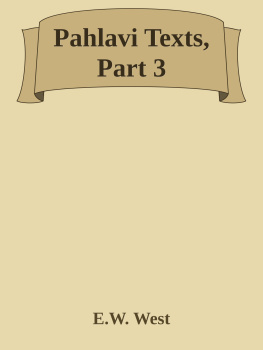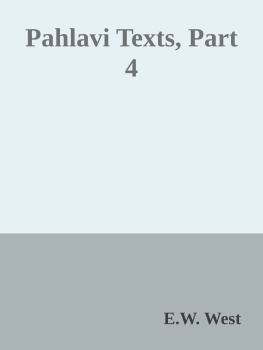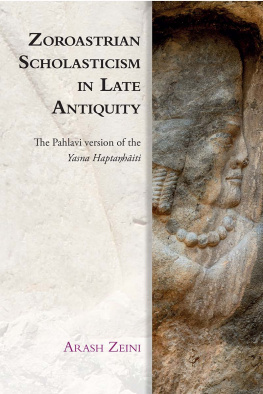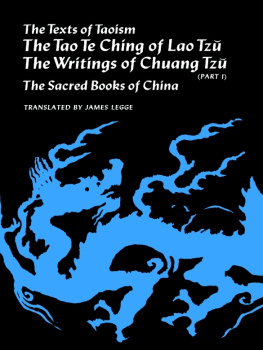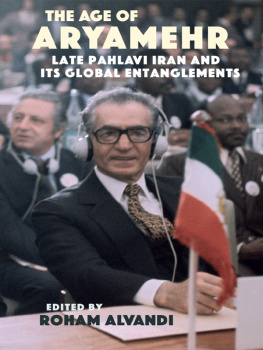E.W. West (tr.) - Pahlavi Texts, Part 1
Here you can read online E.W. West (tr.) - Pahlavi Texts, Part 1 full text of the book (entire story) in english for free. Download pdf and epub, get meaning, cover and reviews about this ebook. genre: Detective and thriller. Description of the work, (preface) as well as reviews are available. Best literature library LitArk.com created for fans of good reading and offers a wide selection of genres:
Romance novel
Science fiction
Adventure
Detective
Science
History
Home and family
Prose
Art
Politics
Computer
Non-fiction
Religion
Business
Children
Humor
Choose a favorite category and find really read worthwhile books. Enjoy immersion in the world of imagination, feel the emotions of the characters or learn something new for yourself, make an fascinating discovery.
- Book:Pahlavi Texts, Part 1
- Author:
- Genre:
- Rating:3 / 5
- Favourites:Add to favourites
- Your mark:
- 60
- 1
- 2
- 3
- 4
- 5
Pahlavi Texts, Part 1: summary, description and annotation
We offer to read an annotation, description, summary or preface (depends on what the author of the book "Pahlavi Texts, Part 1" wrote himself). If you haven't found the necessary information about the book — write in the comments, we will try to find it.
Pahlavi Texts, Part 1 — read online for free the complete book (whole text) full work
Below is the text of the book, divided by pages. System saving the place of the last page read, allows you to conveniently read the book "Pahlavi Texts, Part 1" online for free, without having to search again every time where you left off. Put a bookmark, and you can go to the page where you finished reading at any time.
Font size:
Interval:
Bookmark:

This is part I of the Sacred Books of the EastPahlavi Texts translation.It includes a number of crucial medieval Zoroastriantexts: the Bundahis, Selections of Zad-sparam, the Bahman Yast, andthe Shayast la-Shayast, as put into writing about the sixth century C.E.The Bundahis is of note because it is a collection of Zoroastriantraditions about the creation of the world.The Shayast la-Shayast deals with matters of ritual impurity, sin, and ritualsrelated to purification, including many cases related to dead bodies.The Bahman Yast is a prophetic text, which details thousands ofyears of history, including the downfall and rebirth of the Zoroastrian faith.West compares these texts respectively to the Biblical books of Genesis, Leviticus and Revelation.
Title PageContents
INTRODUCTION.
Page | |
The Parsi Scriptures | |
The Pahlavi Language and Literature | |
The Bundahis | |
The Selections of Zad-sparam | |
The Bahman Yast | |
The Shayast la-shayast | |
Concluding Remarks | |
| |
BUNDAHIS | |
SELECTIONS OF ZAD-SPARAM | |
BAHMAN YAST | |
SHAYAST LA-SHAYAST | |
Index | |
Errata | |
Transliteration of Oriental Alphabets adopted for the Translations of the Sacred Books of the East |
THOUGH we must look to the Avesta for information regarding the main outlines of the Parsi religion, it is to Pahlavi writings we must refer for most of the details relating to the traditions, ceremonies, and customs of this ancient faith, which styles itself emphatically 'the good religion of the Mazdayasnians,' and calls its laity bahdinan, or 'those of the good religion.' In the fragments of the Avesta which still exist, we may trace the solid foundations of the religion, laid by philosophic bards and lawgivers of old, with many a mouldering column and massive fragment of the superstructure. erected upon them by the ancient priesthood. These are the last remnants of the faith held by Cyrus, the anointed of the Lord (Isaiah xlv. 1), the righteous one (Is. xli. 2), or eagle (Is. xlvi. 11), whom He called from the east, and the shepherd who performed His pleasure (Is. xliv. 28); scattered fragments of the creed professed by Darius in his inscriptions, when he attributes his successes to 'the will of Auramazda;' and mouldering ruins of the comparatively pure religion of oriental 'barbarism,' which Alexander and his civilising Greek successors were unable wholly to destroy, and replace by their own idolatrous superstitions. While in the Pahlavi texts we, find much of the mediaeval edifice built by later Persian priest craft upon the old foundations, with a strange mixture of old and new materials, and exhibiting the usual symptom of declining powers, a strong insistence upon complex forms and minute details, with little of the freedom of treatment and simplicity of outline characteristic of the ancient bards.
To understand the relationship between these two classes of Parsi sacred writings, it must be observed that the Avesta and Pahlavi of the same scripture, taken together, form its Avesta and Zand, terms which are nearly synonymous with 'revelation and commentary.' Both words are derived from verbal roots implying 'knowledge;' Avesta being the Pahlavi avistak, which may most probably be traced to the past participle of a, 'to,' + vid, 'to know,' with the meaning of 'what is announced' or 'declaration;' and Zand, being the Pahlavi form of Av. zainti (traceable in the word azaintis), must be referred to the root zan, 'to know,' with the meaning of 'knowledge, understanding .' European scholars, misled probably by Muhammadan writers, have converted the phrase 'Avesta and Zand' into 'Zend-Avesta,' and have further identified Zand with the language of the Avesta. This use of the word Zand is, however, quite at variance with the practice of all Parsi writers who have been independent of European influence, as they apply the term Zand only to the Pahlavi translations and explanations of their sacred books, the original text of which they call Avesta. So that when they use the phrase 'Avesta and Zand' they mean the whole of any scripture, both the Avesta text and Pahlavi translation and commentary. And the latter, being often their only means of understanding the former, has now become of nearly equal authority with the Avesta itself. It is probable, indeed, that the first Zand was really written in the Avesta language, as we find many traces of such Avesta commentaries interpolated both in the Avesta and Pahlavi texts of the Parsi scriptures; but this is rather a matter of, European inference than of Parsi belief. The later (or Pahlavi) Zand appears also, in many places, to be merely a translation of this earlier (or Avesta) Zand, with additional explanations offered by the Pahlavi translators.
Regarding the sacredness of these Pahlavi translations, in the eyes of the Parsis, there can be no manner of doubt, so far as they cannot be shown to be inconsistent with the
original Avesta text. But besides these translations there is another class of Pahlavi religious writings whose authority is more open to dispute. These writings are either translations and Zands of Avesta texts no longer extant, or they contain the opinions and decisions of high-priests of later times, when the Pahlavi language was on the decline. Such writings would hardly be considered of indisputable authority by any Parsi of the present day, unless they coincided with his own preconceived opinions. But for outsiders they have the inestimable value either of supplying numerous details of religious traditions and customs which would be vainly sought for elsewhere, or of being contemporary records of the religious ideas of the Parsis in the declining days of their Mazdayasnian faith. It is with a few of such writings this volume has to deal; but before describing them more minutely it will be desirable to give some account of the Pahlavi language in which they are written.
Font size:
Interval:
Bookmark:
Similar books «Pahlavi Texts, Part 1»
Look at similar books to Pahlavi Texts, Part 1. We have selected literature similar in name and meaning in the hope of providing readers with more options to find new, interesting, not yet read works.
Discussion, reviews of the book Pahlavi Texts, Part 1 and just readers' own opinions. Leave your comments, write what you think about the work, its meaning or the main characters. Specify what exactly you liked and what you didn't like, and why you think so.

